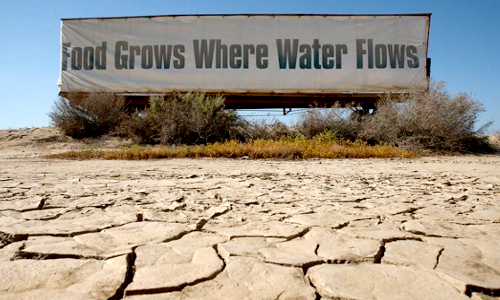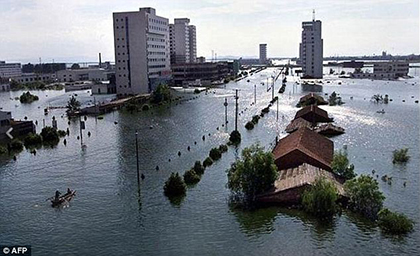by Barry Sheppard
January 9, 2016
California has what’s called a Mediterranean climate, which means it has two seasons, wet and dry. The wet one usually starts in November and lasts through the winter and early spring and is characterized by rain, and snow in the northern part of the Sierra Nevada Mountains. In the dry season, from mid-spring through October, there is little or no rain. In recent years the wet season has become shorter and with less rain and snow, while the dry one has lengthened and grown hotter. This reached the point four years ago that the state was officially declared to be in a drought, which has continued to the present and become more extreme.
Global warming is not only exacerbating the drought, it has likely transformed the ecology of the state well into the future, as I’ll discuss below. I’ll first survey the effects of the drought so far.
The dry season is marked by wildfires, which have become progressively worse in the course of the drought. The year 2015 has seen twice the number of such fires as usual, with one especially destructive that virtually wiped out a small town, burning down to the foundations nearly 500 homes. It spread so fast that seasoned firefighters said they had never seen anything like it.
Reservoirs are at historic lows, most down well below half of the historic average. Scientists also report a groundwater emergency. Jay Famiglietti, a senior water scientist at the NASA Jet Propulsion Laboratory in California, warned last March that there is only one year’s worth of water left in the state’s reservoirs, and that groundwater also is in danger.
At the end of the wet season last April, which was hardly “wet” at all, the snow pack in various parts of the Sierra Nevada, the runoff from which is key to supply water to the state in the summer, was between 16% and 22% of normal levels.
Devastating Impacts

Agriculture is big business in the state, concentrated in the Central Valley that runs between the Sierra Nevada and coastal mountain ranges. More than half of the state’s crop value comes from fruit and nuts, and about a quarter from vegetables. These commodities amount to over 60% of total U.S. fruit and nut production and 51% percent of vegetables.
Agricultural losses due to the drought are in the tens of billions. Some crops have been abandoned. As growers scramble for the depleting water supply, they have turned to pumping up more and more groundwater from ever deeper wells. A result is that the surface ground level in the Valley has dropped by over one foot.
There are many smaller effects of the drought. One example is that black bears have been coming down from hills into a small town, looking for food, as their regular food supplies are dwindling. This includes acorns these omnivores rely on, as oak trees in these hills have died or become so weak they cannot produce acorns.
California Governor Jerry Brown has declared a state of emergency and called for a 25% reduction in water use, a target aimed at individuals and small businesses–not agribusiness, which sucks up 80% of California water. There have been small cutbacks imposed on this sector by necessity.
Also let off the hook is Big Oil. California is a major oil producer. An article in the San Francisco Chronicle reports:
“A typical Central Valley oil well pulls up 9 or 10 barrels of water for every barrel of petroleum that reaches the surface. In addition, companies often flood oil reservoirs with steam to coax out the valley’s thick, viscous crude, which is far heavier than petroleum found in most other states. They pump high-pressure water and chemicals underground to crack rocks in the controversial practice of hydraulic fracturing. They use acid and water to clear up debris that would otherwise clog their oil-producing wells.”
All that leftover contaminated water has to go somewhere. According to the Chronicle, state regulators allowed oil companies to fill 170 aquifers that could be suitable for drinking or irrigation with fracking waste. Companies drilled another 253 wells close to aquifers, and the waste can seep into them. So not only does Big Oil use up a lot of water, it poisons the water it does use, which contaminates more water sources.
Who Conserves? Who Wastes?
In addition to favoring agribusiness and Big Oil in the emergency, among individuals there is a big discrepancy between those who are conserving and those who aren’t. Ragina Johnson writes in Socialist Worker:
“Forty-eight percent of wealthier homeowners with incomes above $100,000 a year say it would be ‘difficult’ to conserve water. While many people with more modest means have replanted with indigenous and drought-tolerant plants, the well-to-do appear to be resisting with vigor.
“Conservative talk show host Steve Yuhas is a case in point. He recently ranted on social media that rich homeowners ‘should not be forced to live on property with brown lawns, golf on brown courses or apologize for wanting their gardens to be beautiful… We pay significant property taxes based on where we live. And, no, we’re not all equal when it comes to water.’
“That’s true, unfortunately. We aren’t ‘all equal’ when it comes to access to vital resources, like water–or food or housing, for that matter. Rancho Santa Fe, where Yuhas lives, is a gated community with multi-acre estates, country clubs and ranches. There, water consumption has gone up by 9 percent since Brown’s mandatory 25 percent reduction went into effect…
“One example from the Bay Area: The historically Black and work-class city of Oakland uses 57 gallons per person per day, compared to Diablo, an elite community a 30-minute drive away, where use is at 345 gallons per person.”
Will El Niño Be the Savior?
El Niño refers to the Christ Child, because the weather phenomenon of that name (a warming of Pacific coastal waters) appears near South America first around Christmas. The story goes that it brings a Christmas present in the form of abundant fish off the Pacific coast.
Noah S. Diffenbaugh, associate professor of earth system science at Stanford, and Christopher B. Field, director of the department of global ecology at the Carnegie Institution for Science, wrote recently in The New York Times, September 18, 2015):
“As wildfires rage, crops are abandoned, wells run dry and cities work to meet mandatory water cuts, drought-weary Californians are counting on a savior in the tropical ocean: El Niño. This warming of the Pacific occurs about every five years, affecting climate around the globe and bringing heavy winter precipitation to parts of California. The state experienced two of its wettest years during two of the strongest El Niños, in 1982-83 and 1997-98.
Flooding caused by El Niño in 1997-98.“Now climatologists have confirmed that a powerful El Niño is building, and forecasts suggest a high likelihood that El Niño conditions will persist through the next several months. So we in California expect a rainy winter. But before everyone gets too excited, it is important to understand this: Two physical realities virtually ensure that California will still face drought, regardless how this El Niño unfolds.
“The first is that California has missed at least a year’s worth of precipitation, meaning that it would take an extraordinarily wet rainy season to single-handedly break the drought. Even if that happened, we would most likely suffer from too much water too fast, as occurred in the early 1980s and late 1990s, when El Niño delivered more rainfall than aquifers could absorb and reservoirs could store.
“The second is that California is facing a new climate reality, in which extreme drought is more likely… Our research has shown that global warming has doubled the odds of the warm, dry conditions that are intensifying and prolonging this drought, which now holds records not only for lowest precipitation, but also for the lowest spring snow pack in the Sierra Nevada in at least 500 years. These changing odds make it much more likely that similar conditions will occur again, exacerbating other stresses on agriculture, ecosystems and people.”
The research establishing that this past year’s snow pack was the smallest in 500 years was based on studies of tree rings in centuries-old Blue Oaks, which strongly correlate with summer runoff from the Sierra snow pack. The study indicated that present drought conditions are a once-in-a-thousand-years event. In the context of global warming, it boggles the imagination to believe that this rare event is a random coincidence with global warming. The authors add:
“At the same time, extreme wet periods may also increase because a warming atmosphere can carry a larger load of water vapor. In a possible preview, persistent El Niño conditions this year could force Californians to face both flooding and drought simultaneously. The more rainfall there is, the more water will be lost as runoff or river flow, increasing the risk of flooding and landslides. Add in the fact that the drought and wildfires have hardened the ground [increases that likelihood].”
They caution, “We are not arguing that the drought has been caused by climate change alone, or that all weather disasters have a link to climate change…As with the California drought, climate change is an important thumb on the scale, increasing the odds of particular extremes in specific places.”
Present and Future Danger
Diffenbaugh says that his and Field’s study, combined with previous studies, “provide strong evidence that global warming has substantially increased the probability of getting these extremely low snow conditions.” This and other studies indicate that while El Niño is likely to increase the snow pack for 2016, which will ameliorate somewhat the drought next summer, the drought will not be over. If this projection is correct (and this is the scientific consensus), the drought will continue for years to come.
The California Drought Update on November 25, 2015 commented: “Experts caution that heavy rain and flooding in some parts of the state will not necessarily end California’s four-year drought. State and local water managers are urging the public to prepare for possible floods and extreme weather events, while still conserving as much water as possible.”
To understand the impact all this is having and will have in the future on California’s economy, it is useful to look at the state’s water use structure. The importance of the snow pack in the Sierra Nevada is indicated by the fact that its melt runoff fills reservoirs that provide a third of all the drinking water for the state, as well as water to fight fires and generate electricity.
The Central Valley is naturally a desert. It has become fertile only through massive irrigation from water pumped from the rivers that depend on the snow pack. The snow accumulates well north of the Central Valley. Water pumped from the rivers that depend on the snowpack not only irrigates the farms in the Valley, but is an important source for Los Angeles and all of southern California.
The clear present and future danger resulting from the disruption of this water use system is obvious. To carry through the large-scale revamping necessary to cope with this disaster runs directly into the obstacle of the big capitalist firms involved, which are driven by the iron necessity of maximizing their profits, no matter the costs to society at large. As is the case with all the problems caused by the burning of fossil fuels, no long-term solutions are available under the capitalist system.
Partial reforms can be fought for and won, but such struggles will pit the working people against powerful capitalist interests, opening the door to understanding that the system itself must be changed–along the lines of the slogan that has become popular in the environmental movement: System Change, Not Climate Change.
Barry Sheppard is a member of Solidarity in the San Francisco Bay Area of California.

